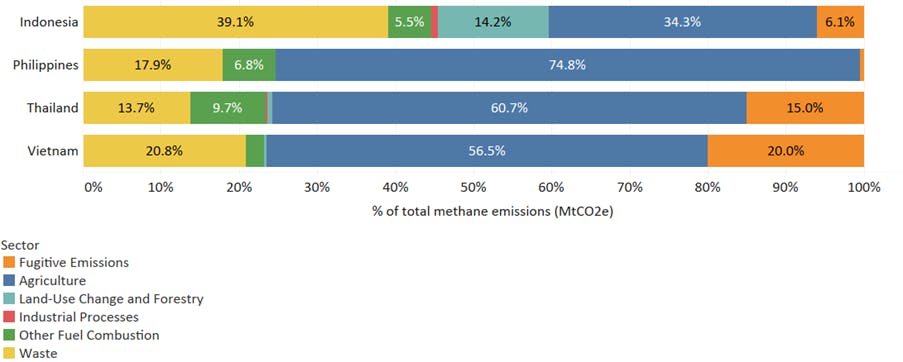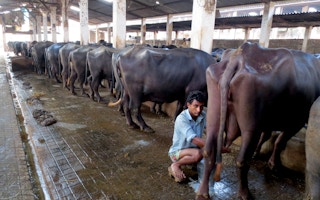Methane has been a buzzword since over 100 countries signed the Global Methane Pledge, formally announced at the United Nations (UN) climate conference last November (COP26). The commitment to cut global methane emissions by at least 30 per cent by 2030 was welcome. Methane is a greenhouse gas which is 27 times as potent as carbon dioxide, and requires heavy cuts in emissions by 2030 for a 1.5 degree scenario. Also heartening was the participation of five Asean countries in the Pledge: Indonesia, Malaysia, the Philippines, Singapore and Vietnam, whose combined methane emissions made up 6.5 per cent of the global total in 2018. Most Asean countries have also addressed methane in their national climate commitments. But now they face the challenge of rapidly implementing solutions for meaningful reductions in methane.
Methane emissions can come from different sectors, mainly agriculture, waste and fossil fuels. What is a blessing for some and a curse for others: depending on where one’s methane comes from, solutions can range from dirt cheap to dauntingly expensive. Generally, most of the affordable measures can be found in the oil and gas sector. The 2021 Global Methane Assessment noted that even when considering only the cheapest solutions in this sector (less than US$600/tonne of methane, or US$21/tonne of carbon dioxide equivalent), annual reductions can potentially reach 18-32 metric tonnes (Mt). In the waste sector, low-cost solutions can yield 10-20 Mt of annual reductions. But things look less exciting in agriculture: measures in livestock cost US$600-1,000/t, while those in rice cultivation cost US$150-3,000/t.
In short, there are different strokes for different folks. Those whose methane mostly comes from oil and gas or waste can seize opportunities for proven, low-cost measures, while those targeting rice cultivation or livestock have a steeper hill to climb.
“
While some countries may tackle methane through simpler strategies, others face the conundrum of deciding whether cutting methane is worth the expensive and complex measures available.
Take Brunei, Malaysia and Singapore (Figure 1). Over 97 per cent of Brunei’s annual methane emissions come from gas leaks (fugitive emissions) mostly from oil and gas facilities. In Malaysia, waste and fugitive emissions dominate. Singapore’s largest contributor is the waste sector. In oil and gas, leakage detection practices and installing efficient equipment can have negative marginal costs. Brunei already aims to adopt zero routine flaring (avoiding the wasteful release of gas from facilities) as a major climate strategy. The remaining hurdles are setting up monitoring and reporting systems based on credible frameworks, alongside concrete plans. In the waste sector, treating biodegradable waste or capturing waste gas for electricity generation can also have low or negative marginal costs. In practice, however, some projects have met financial and technical obstacles. This is where countries could benefit from knowledge sharing on financing and implementation: last year, Singapore leveraged investor appetite in green bonds for the Tuas Nexus Integrated Waste Management facility, with waste-to-energy capabilities.
The Bugbear of Waste and Fugitive Emissions

Figure 1: Methane emissions of Brunei, Malaysia and Singapore in 2018. (Source: WRI) Image: ISEAS – Yusof Ishak Institute via Fulcrum.sg
For some, agriculture is the focus (Figure 2). 79.2 per cent of Cambodia’s methane emissions in 2018 came from agriculture. Laos and Myanmar, whose biggest agriculture product is rice, had 89.3 per cent and 83.5 per cent of methane coming from agriculture. The Philippines, Thailand and Vietnam are also major rice producers. In rice cultivation, methane comes from bacteria in waterlogged paddies; solutions include using sulfates to inhibit methane production, or alternative rice hybrids. Even cheaper measures like Alternate Wetting and Drying (AWD) techniques, which reduce methane emissions by alternating between dry and flooded conditions in rice paddies, are not easy. Although AWD has been studied extensively, scaling up is an elusive task. In the Philippines, AWD adoption still hovered under 5 per cent of irrigated areas by 2016, with researchers citing constraints in incentives and institutional support.
Agriculture Takes the Cake

Figure 2: Methane emissions of Cambodia, Laos and Myanmar in 2018. (Source: WRI) Image: ISEAS – Yusof Ishak Institute via Fulcrum.sg
Some countries have multiple major sources of methane with differing costs of abatement (Figure 3). Indonesia has to address both agriculture and waste, each contributing over a third of emissions. In the Philippines, agriculture and waste contributed 74.8 per cent and 17.9 per cent of methane emissions respectively. In Thailand and Vietnam, agriculture contributed 60.7 per cent and 56.5 per cent respectively, but both had a significant share of waste and fugitive emissions. These countries may face challenges in agriculture but can still take advantage of opportunities in the waste and oil and gas sectors.
Problems of Farming and Waste

Figure 3: Methane emissions of Indonesia, Philippines, Thailand and Vietnam in 2018. (Source: WRI) Image: ISEAS - Yusof Ishak Institute via Fulcrum.sg
While some countries may tackle methane through simpler strategies, others face the conundrum of deciding whether cutting methane is worth the expensive and complex measures available. How can methane abatement stay in the spotlight? The good news is that some solutions, including in rice cultivation, have multiple co-benefits. In addition to reducing methane, AWD helps to build drought resilience, increases yields and prevents disease. Projects already seeking support to improve agricultural practices could report their methane reduction potential to sweeten the deal. Beyond finance and technology, countries also need support to design effective policies for scaling up measures. Those with similar emission profiles may benefit from sharing practices on monitoring, financing and implementing solutions, including through existing bodies like the Asean Working Group on Chemicals and Waste and Asean Energy Regulators’ Network. Methane requires diverse approaches across multiple sectors, so a variation of approaches might well be the way forward.
Qiu Jiahui is Research Officer at the Climate Change in Southeast Asia Programme, ISEAS – Yusof Ishak Institute.


















